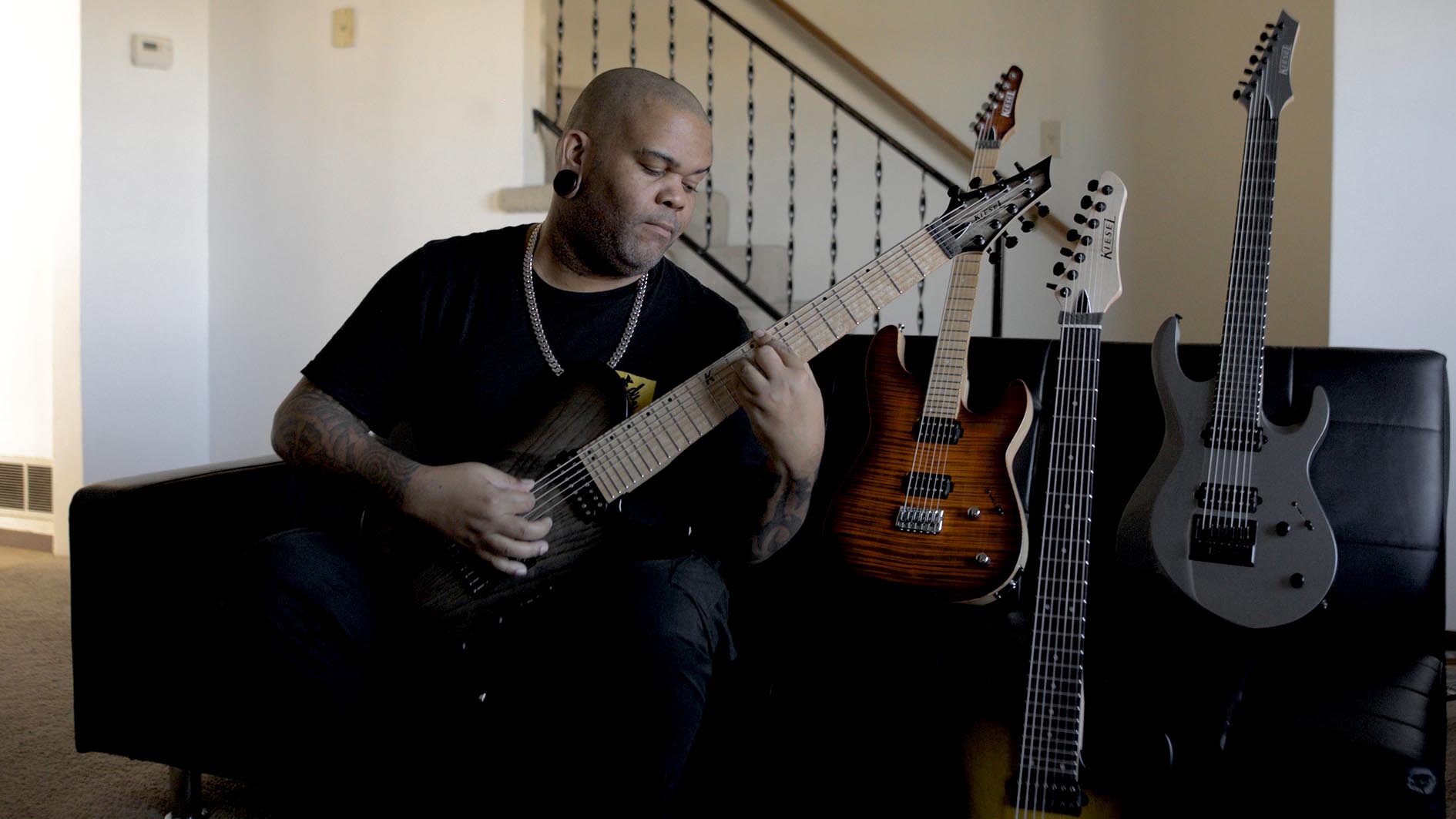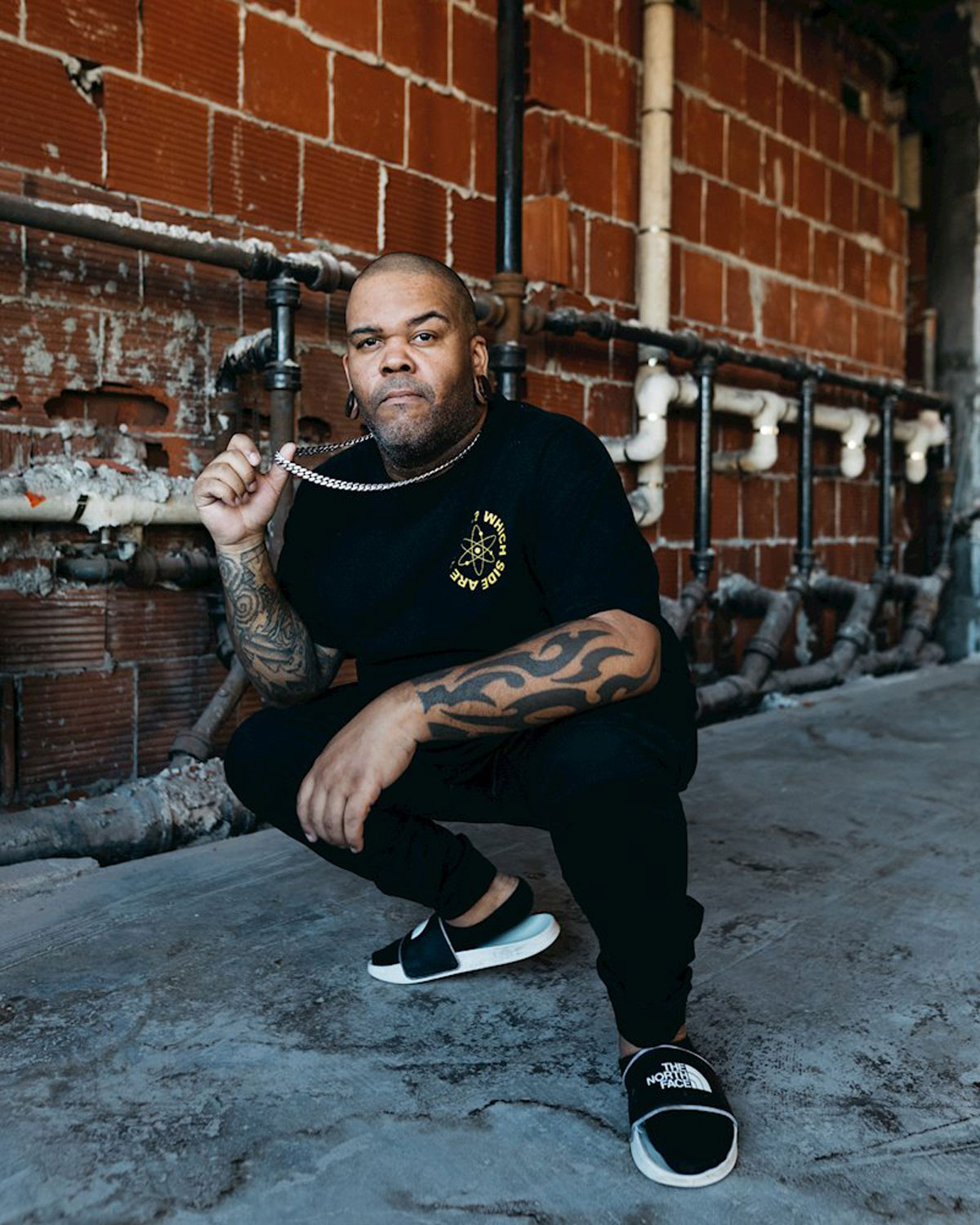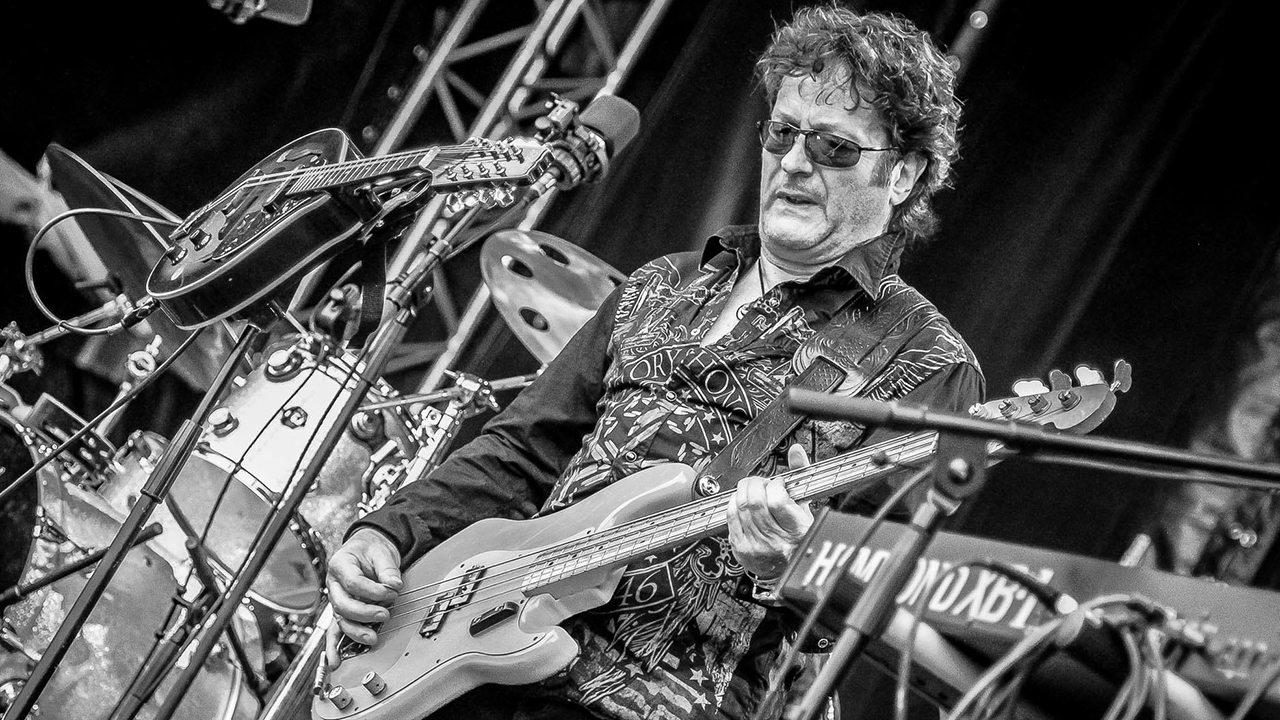Joshua Travis on his love of rhythm guitar: “I’ve always wanted to hit you hard. Lead playing doesn’t hit me like that – it doesn’t punch you in the face”
The Emmure guitarist talks tackling the lower registers with 7-, 8- and 9-strings, and how his all-out work ethic inspired pummeling new solo EP, NO REST

That Joshua Travis’s debut solo EP is titled NO REST should come as no surprise. Over the years, the American riff tactician has put together an impressively brutalizing body of work that has seen him steadily coursing through frantic mathcore licks with the Tony Danza Tapdance Extravaganza, delivering tech-djent heaviness with Glass Cloud, and more recently barreling through groove-forward, nine-string booms as the lead guitarist of Emmure.
Putting his name at the top of the marquee may be new, but NO REST ultimately builds off the guitarist’s affinity for body-obliterating rhythmic heaviness.
“For all of my projects, it all starts with me anyways. I’m just writing whatever it is that I’m writing,” Travis explains to Guitar World.
Travis keeps things relatively in-house on NO REST, delivering all of the precision judding to pieces like All Out War on guitar, bass, and drums. That said, he welcomed help from friends like Andy Cizek (Monuments), Ryo Kinoshita (Crystal Lake) and Chad Kapper (Frontierer), whom added their respective piercing screams to the record.
And while Travis goes for the throat on percussively picked salvos like Leviathan, guest soloist Stephen Taranto rips into the multi-layered, interlocking shred harmonies on the EP’s opening Web Of Lies like a three-headed hydra.
Speaking with Guitar World, Travis got into the blunt force missives of his debut EP, his new Kiesel signature model, and how to rethink your literal and metaphorical grip on the guitar when it comes to hoisting a nine-string.
Had your The Hollow single you’d made with Andy Cizek in 2020 pushed you towards making this EP, at least in terms of getting your toes wet with the idea of releasing solo material?
All the latest guitar news, interviews, lessons, reviews, deals and more, direct to your inbox!
“You could say so, but even when I did these singles with Andy and Charles Caswell, I was never thinking, ‘This is going to be my solo stuff.’ That idea never [struck me] until I started talking with SharpTone Records, where they were like, ‘Why don’t we actually [put this out] as your solo thing?’ Fast-forward to now, I just can’t stop. I have 19 records’ worth of stuff just sitting here. It’s super-exciting.”
What was the first piece to officially get the EP rolling?
“It would’ve been that song with Andy, Web of Lies. I just love working with him; his voice is so monstrous. I did that track with him and it was full steam after that. It was like a domino effect with everybody else’s features. Some people got the idea that Andy was the vocalist for everything that I was doing. It’s not necessarily that, but I’ve got other [songs] with Andy already done. We’re waiting to put that out.”
I like percussive and rhythmic things, and seeing how wild you can get in a phrase. That’s really what does it for me, but I also love lead players – people that can make a guitar sing like that
There are obviously some groove parallels to your broader body of work within NO REST, but there’s also this massive lead on Web of Lies that doesn’t even exist anywhere else on the EP.
“Well, I am not a lead player. I really get into rhythm. I like percussive and rhythmic things, and seeing how wild you can get in a phrase. That’s really what does it for me, but I also love lead players – people that can make a guitar sing like that.
“I know so many shredders that I was like, ‘Who can I get to do a guitar feature?’ I’ll change the song; if it’s the right player, I’ll even make it longer. Stephen Taranto is one of the most insanely fast, clean, and tasteful shredders ever. I’m always watching his videos online. I just went for it and asked if he would do a feature on the song. I really didn’t think he would be interested, but he sent that back!”

Let’s get into your rhythm playing on the EP, which is likewise sick. There’s a lot of compound, multi-rhythmic layering on this. How have you developed that side of your playing over the years, if that’s been your focus?
“It wholeheartedly comes from being a drummer, originally. But then with the person who taught me guitar, I really liked the way it could persuade or dictate how you feel with certain types of melodies or chord phrasings. It can really sway how you feel in a moment. I loved that idea!
“Then I started thinking, ‘What if you could couple that with rhythm?’ You can still really capture a feeling but also have this percussive element behind it.
“The lead stuff... don’t get me wrong, I love it, but I never put that kind of time into it. I’ve always wanted to hit you hard. Lead playing doesn’t hit me like that; it doesn’t punch you in the face.”
I don’t tune normally. You couldn’t pick my guitars up and play any song – well, you could play my songs, but nothing else
You’d recently announced a partnership with Kiesel around your new signature nine-string Aries. Going back to the Tony Danza days, you’d been more of an eight-string player, correct? Can you get into how you leveled up to nine-strings?
“I think I’ve been doing nines for close to 10 years, a really long time. When we were in Tony Danza, we were playing seven-strings forever and then I gradually shifted into eight-strings. My next band [Glass Cloud] was when I was introduced to the nine-string. It was still a very heavy instrument – 30-inch scales; I think we had 26 frets on them. It was pretty gnarly.
“For a lot of six-string players, they see a nine-string and are like, ‘No’ [laughs]. They see this thing and are like, ‘What are you doing with that? Why don’t you just play bass?’ I understand your argument, but here’s where that argument is defeated: this guitar starts at standard E, so this is not bass register. Just because I can go all the way down to a bass register doesn’t make it a bass. I feel you’re looking at 11-plus strings to really get all the way down to something subsonic.
“I don’t tune normally, either. I want to say that the standard for nine-strings is C#, but this is tuned so weird. You couldn’t pick my guitars up and play any song – well, you could play my songs, but nothing else.”
Is there a consistent tuning you keep on there, though?
“This thing starts [at the highest string] at an E flat. It goes down to A, and then G – we’re already weird, here – and then two Cs. The lower of those Cs is actually 16 cents sharp. Any time I use the Cs together it creates a natural chorusing. Then you have D, A, D, A – I like to do octaves on the low strings; that’s how I use them most of the time.
“You can’t play a [standard] chord on it. I use it the same way you would have an orchestral section put together.”
Was there much of a learning curve that came with scaling up to nine-strings? What would you suggest to someone that wants to level up?
“I don’t know if I’d call it a learning curve as much as I would call it a comfortability curve. I started off on a seven-string, whereas generally a lot of players start on the six; I didn’t get a six-string ‘til way later. I rotated between sevens and eights for an extremely long time [before] I got the nine.
I just look at it as more options. Just because you can go that low, it doesn’t mean you have to go that low
“With the first nine that I ever had, the sizing and the sheer thickness of the neck was too much. It wasn’t the most comfortable thing. Fast-forward 10 years, and now I’ve really gotten that dialed in [to where it’s] actually really comfortable to play.
“Going from seven-string to nine-string is a jump I make with Emmure all the time. It’s kind of a big jump, when you think about it. Even though it’s only two more strings, it’s kind of the same thing you would feel if you played an Ibanez and then you played an Ernie Ball. They’re just not going to feel alike.
“Just learn the curvature; learn the profile; learn how to move around on the neck. You don’t grab it and play like a six-string; it’s a lot bigger than that. You start noticing things like where you would typically be on the back of [a smaller] neck, [and] you start moving your hand around. You can reach things easier when you relocate your hand. Some people seem to be afraid to try that out, which I get, but it’s no reason to be intimidated by it.
“I just look at it as more options. Just because you can go that low, it doesn’t mean you have to go that low.”
Were you working with an Aries on these NO REST sessions?
“No, the EP is all seven-string. The first song is standard G; the next three are drop G; oddly enough the last song is drop F, but still on the seven-string.”
Can we get into the playing on a piece like Disdain? It’s a pretty nasty, ascending slam, but there are also some super-skittery runs going on in the breakdown.
“Disdain is high-energy. I wanted the first track [Web of Lies] to be the song that kicks the door open, and the next three tracks to feel like the rampage. Like, we kicked the door in and now we’re frantically running through everything; the last song [All Out War] is like we exited the building and left a path of destruction behind us.
There are a couple of string skips in that little run that I wish I hadn’t done, but I’ve put it to tape. I never thought about playing this live… I was just having fun
“Disdain has got a squirrelly little part towards the end there. Every time I listen back to it, [though], I wish I would have never done that. It’s not that easy to play. I [generally] enjoy finding the fun in the simplicity. There are a couple of string skips in that little run that I wish I hadn’t done, but I’ve put it to tape. I never thought about playing this [live]… I was just having fun.”
If NO REST was recorded with a seven-string, are you writing anything on the Aries at the moment?
“Oh yeah, it’s in full swing right now. I’m also working on [Emmure’s] new record right now. That’s the reason why the name of my EP is NO REST, because it just doesn’t stop! Even while I’m sitting here doing this interview, as soon as I’m done I have to go work on [Emmure] more [and then] we have to shoot video playthroughs for NO REST.”
Do you like being in that kind of a crowded, no-rest headspace?
“Do I like the push? At times, yes, but there are also times where it’s like, ‘Man, I wish I could just take two days to decompress, power everything down, not listen to anything, and just enjoy a movie.’
“When I’m not working on the EP, or the Emmure stuff, I also have other bands that I produce, and opportunities to tour with other friends’ bands. I’m trying to do all these things, but ultimately once you make it through everything it feels so good knowing what you’ve accomplished.”
- NO REST is out now via SharpTone Records.
Gregory Adams is a Vancouver-based arts reporter. From metal legends to emerging pop icons to the best of the basement circuit, he’s interviewed musicians across countless genres for nearly two decades, most recently with Guitar World, Bass Player, Revolver, and more – as well as through his independent newsletter, Gut Feeling. This all still blows his mind. He’s a guitar player, generally bouncing hardcore riffs off his ’52 Tele reissue and a dinged-up SG.

